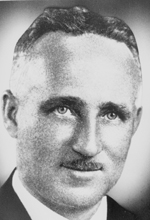1925: R.W. 'Billy' Boyle, P.Eng.

Dr. Robert William (Billy) Boyle was born in Newfoundland on April 18, 1883. His academic record was stellar, achieving a scholarship upon graduating from high school, and receiving subsequent awards while studying electrical engineering at McGill University.
He was granted the first PhD in physics at McGill, then continued his studies in Cambridge and Manchester. He returned to McGill in 1911 to teach physics. A year later he was chosen to head the University of Alberta's department of physics. Under his direction the department became noted for the quality of instruction and emphasis on research. He would subsequently establish the department of electrical engineering.
During World War I Boyle joined the Anti-Submarine Division of the admiralty where he pioneered research on "asdics", which detected submarines almost a mile away. He returned to the university in 1919, and was later appointed dean of the faculty of applied science.
At the time of these formative years of the faculty, Boyle was an enthusiastic supporter of the newly established Association of Professional Engineers of Alberta(APEA; now The Association of Professional Engineers, Geologists and Geophysicists of Alberta). In 1925 he was elected its sixth president. During his tenure, provision was made to have engineering students recognized as student members of the association.
In 1928, Boyle was asked to examine research establishments in Europe. His report on these visits made a significant contribution to the design of the laboratories of the National Research Council. Boyle was later appointed the first director of physics and electrical engineering at the council, a position he held until his retirement in 1948. He passed away in April 1955 in Europe.
